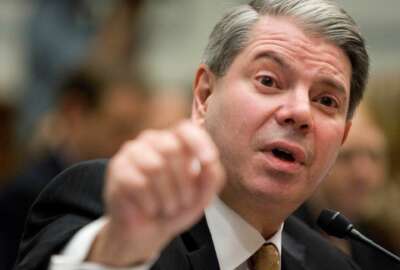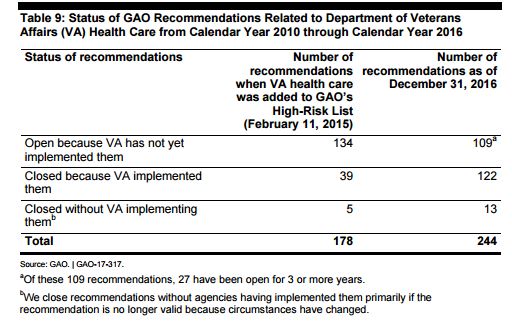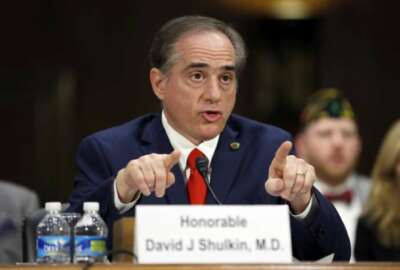
Progress made at VA but not made quickly enough, GAO says
Both the Government Accountability Office and the department's inspector general say leadership at the Veterans Affairs Department is committed to removing VA...
The Veterans Affairs Department has shown it’s committed to resolving the hundreds of recommendations the Government Accountability Office and its inspector general have suggested in recent years, but both entities say they’ve seen little concrete action.
Comptroller General Gene Dodaro said he was “disappointed” by the lack of progress he’s seen at the department. VA health care made GAO’s biennial High-Risk List for the second time in 2017.
“I’ve met with [former] Secretary McDonald three times, once to tell him we were putting them on the high risk list,” Dodaro said before the Senate Homeland Security and Governmental Affairs Committee during a Feb. 15 hearing on the High-Risk List. “He agreed. Second, to tell him they didn’t have a good plan to come off the High-Risk List. And the third time was to offer GAO’s experts in different areas, IT for example, to help them understand best practices and how to do this. We had the meeting but there’s been very little uptake.”
GAO in particular focused its concern on five major areas related to VA health care in 2015, and those areas remain this year.
- Ambiguous policies and inconsistent processes
- Inadequate oversight and accountability
- IT challenges
- Inadequate training for VA staff
- Unclear resource needs and allocation priorities
Since GAO first added VA health care to the High-Risk List in 2015, the department has closed some recommendations, but GAO has added others. VA leadership has said they’re committed, but GAO has seen little specific action.

“Although we concluded in our overall assessment that VA’s actions partially met two of our five criteria for removal from the High-Risk List, it is worth noting that the department made significantly less progress in addressing the action plan criterion than it has in demonstrating leadership commitment,” GAO said in its High-Risk report.
Dodaro said he plans to meet with new Secretary David Shulkin on the these issues. Shulkin began his tenure as secretary last week after the Senate unanimously confirmed his nomination.
The department’s inspector general, Michael Missal, said the story has been similar for him and his team.
“I believe they are trying but there are still some areas which give us great pause,” Missal told the Senate committee.
Dodaro said GAO is particularly concerned by VA’s method for calculating patient wait times. VHA calculates an appointment wait time starting at the veteran’s preferred date that he or she wants to be seen by a doctor, not the date the veteran initially contacts VA to set up an appointment.
“We think they’re waiting too long to measure wait times,” Dodaro said.
The IG released more than 90 summaries of investigations at medical centers across the country over the past year, most of which focused on wait times for appointments.
“The lack of training for schedulers and the lack of understanding of the process by managers created a system in which long wait times were not accurately portrayed to management,” Missal said.
VA is also struggling to predict how much VA health care services will cost and how many veterans may request appointments and care in the future.
Demand for VA care is on the rise, as the department had nearly 9 million enrollees to its health system by the end of fiscal 2016. About 7.9 million veterans were enrolled with VA in 2006. The department’s budget has also increased dramatically during that time from $37.8 billion to $91.2 billion over the past 10 years.
The department’s ability to predict future needs continues to be a challenge,
“It does appear that progress is being made, like for instance with respect to network providers, the physicians who are providing the health care outside of VA, those numbers have increased fairly dramatically, according to VA,” Missal said. “There are still some issues there with respect to the Choice Program that we’re looking at. We’re looking at access. We’re looking at payments as well as the sharing of records. When a veteran goes into the community, there’s an issue in terms of making sure the records get back to VA so that the VA system will have those records as well.”
2017 will likely be a pivotal year for the VA Choice Program, as the current one expires this year without congressional action.
Congress tried unsuccessfully in 2016 to pass either an alternative or an extension to the Choice Program, which former VA Secretary Bob McDonald said was one of his greatest disappointments during his tenure.
Copyright © 2025 Federal News Network. All rights reserved. This website is not intended for users located within the European Economic Area.
Nicole Ogrysko is a reporter for Federal News Network focusing on the federal workforce and federal pay and benefits.
Follow @nogryskoWFED
Related Stories





